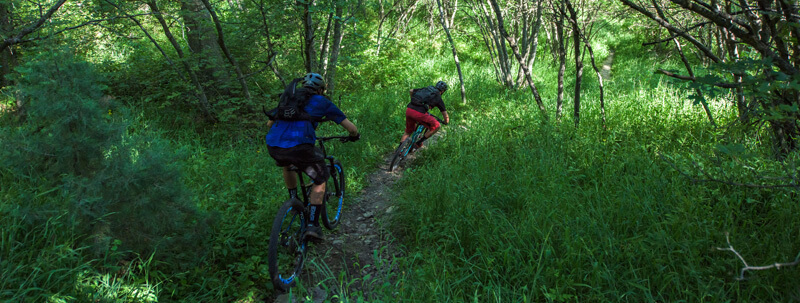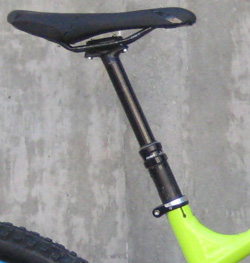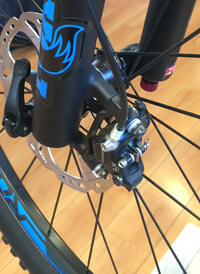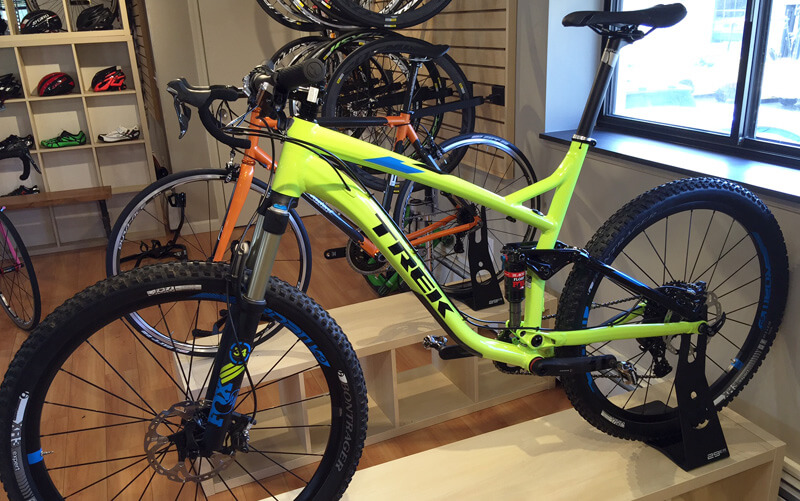A Roadie’s Guide to Buying a Mountain Bike
Once the road season is over we often get asked what road cyclists in New England do to stay active in the fall. Many folks want to put off the trainer, but motivation to stay out on the road can start waning as the days get shorter and weather gets colder. While cyclocross riding and racing work well, my favorite thing to do is to step away from the drop bars for a little while and get a little deeper into the woods.
How I Ride in the Fall:
This year, I spend much of the season preparing for Master’s Track Worlds in Manchester, England developing my power and technique. I achieved my goals at Worlds and when I got home, I was ready to turn off the training metrics that I live by the rest of the summer such as heart rate, speed, power, distance and total hours. For me, the fall is about riding when I want and for how long I want. A chilly day will quickly warm up without much required speed on that first trail I hit. It is fun to set different goals than the road, for example, seeing how much further you can ride up that hill you had to walk part of last week or hold enough speed to smoothly hop over that big branch that you stumbled on last time. Relax and hold speed over that narrow bridge and anticipate the tight turns right after it. If it’s nice out, I like to head out for a longer route, but if it’s cold or getting dark, it is fun to go straight to the single-track and listen to my heart rate climb to in-season highs. Nothing teaches you to round out a pedal stroke faster than teetering up a steep dirt climb and having to remain in your saddle. The steepest hills you’ll ever ride are made of dirt, and the extra focus required to keep your front wheel down while picking the perfect track while at max effort will keep you seeking out that same killer hill again and again. Enjoy the reward of the long winding technical descent as your bike absorbs all the roots and rocks while hovering under you. Riding off-road on any bike will simply make you a better bike handler, and this will transfer to the road as well.
Great Ways to Keep Riding Interesting:
One good strategy to keep fall riding interesting is to plan a group off-road ride. Map out the route ahead of time on www.ridewithgps.com, then forward it to your riding friends with a start time. It makes it feel like an event, yet is so simple and fun. To make it really interesting, mix some road and trails so that everyone has to select their bike accordingly. The rider with a full suspension mountain bike will shred that single-track trail, but the guy on the adventure road bike, like my Moots Routt, will pay him back drilling it on the paved and dirt road connectors between trails.
No time frame is too short to enjoy a quick MTB ride before or after work. I also find that mixing trainer rides and longer off-road adventures on the weekend works really well. If you can’t get outside during the week, just spend 30 minutes on the trainer or cross-training during the week, then look forward to that hour or two excursion the weekend if the weather forecast is better that day.
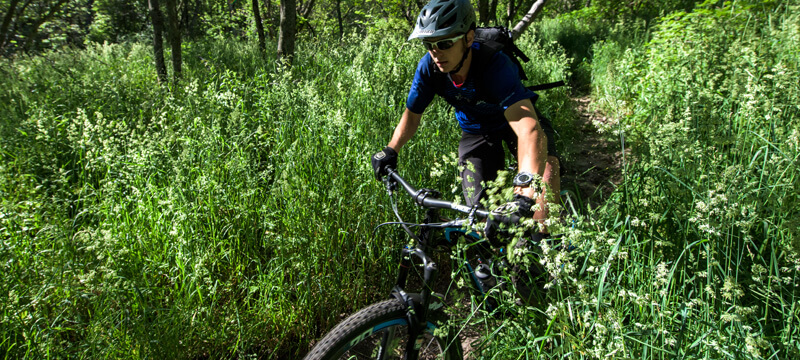 A Range of Dirt Capable Bikes:
A Range of Dirt Capable Bikes:
One great thing about dirt and trails is the wide range of bikes you can use. Fat bikes with their giant “ride-over-anything” tires can basically be ridden anywhere (they are not just for snow…). A performance oriented mountain bike and full suspension can make a rocky and rooted trail feel like you are riding down a winding path of pine needles while gravel/adventure road bikes can accommodate wider tires will allow one bike to be a pavement screamer all summer and an off-road machine in the fall and winter with just a change of tires/wheels. I’ve written about my Moots Routt a bit before and I need to write about my Moots Frosthammer Fat Bike – both great bikes for exploring dirt. However, today I’m going to focus on my mountain bike and how I chose one that fit me well and was well suited to my type of trail riding; in other words, a roadie’s guide to finding and buying a mountain bike.
How I Chose My Mountain Bike:
Like many folks , I started riding mountain bikes later in life. I had a lot to learn and thankfully I had a good support team in my co-workers at Fit Werx to help me get back into mountain biking on the right foot. So, how did I choose my current mountain bike?
, I started riding mountain bikes later in life. I had a lot to learn and thankfully I had a good support team in my co-workers at Fit Werx to help me get back into mountain biking on the right foot. So, how did I choose my current mountain bike?
First, I started speaking with Mike, one of our aforementioned mountain bike aficionados in Fit Werx in Massachusetts. Mike and I discussed which components and features best match the kind of riding I planned on doing and he helped me understand the most important features like whether full suspension or a hardtail made the most sense and what wheel size would suit my riding best before we discussed more of the nitty-gritty of the bike like Boost dropouts, Plus tires and whether a 1x or 2x drivetrain made the most sense for me.
Here is where I ended up and why:
Mountain Bike Wheel Size Choice:
This was arguably a big decision for me as I am big enough that 29” wheels have some good arguments. However, in the end, I chose 27.5 inch wheels since I wanted a bike that could roll through nearly anything but that also handled quickly enough to get me through the tighter or less-ridden single track trails near my house. If there’s a “Jack-of-All-Trades” MTB wheel size, 27.5” is it. Thus I started to focus on 27.5” bikes.
Full Suspension or Hardtail:
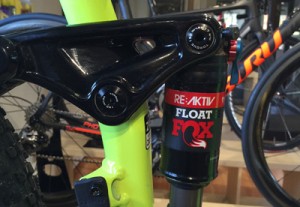 For me, this was an easy decision. A well set-up full suspension bike can make a rocky and rooted trail Cadillac smooth and that is exactly what me, and my back, were looking for. While a hard-tail is lighter, I have a great appreciation for full suspension every time I ride. Besides, modern full suspension bikes don’t have to be particularly heavy. I decided to go with a shorter travel 120mm full-suspension bike as my focus is on riding rugged terrain, but I’m not looking to ride lift accessed trails at warp speed or taking big drops. To put it in perspective, if I see a long flight of stairs, I’m getting off the bike and walking down… 120mm of travel will work great for my riding while someone looking for bigger hit capability than I may want to look at 140mm or more.
For me, this was an easy decision. A well set-up full suspension bike can make a rocky and rooted trail Cadillac smooth and that is exactly what me, and my back, were looking for. While a hard-tail is lighter, I have a great appreciation for full suspension every time I ride. Besides, modern full suspension bikes don’t have to be particularly heavy. I decided to go with a shorter travel 120mm full-suspension bike as my focus is on riding rugged terrain, but I’m not looking to ride lift accessed trails at warp speed or taking big drops. To put it in perspective, if I see a long flight of stairs, I’m getting off the bike and walking down… 120mm of travel will work great for my riding while someone looking for bigger hit capability than I may want to look at 140mm or more.
I also liked the idea of a lockout for the rear shock for those firmer uphill grinds, but with the range of full suspension designs out there, lockout wasn’t a requirement as long as the linkage climbed well regardless.
Fit: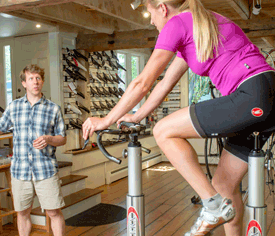
While most people think that fit only matters on road bikes, fit matters on a mountain bike too. If you plan on doing any endurance events it can matter a lot! Using our proven and reliable Fit First Philisophy to bike selection, I used the information from my road fit at Fit Werx to make sure any mountain bike I was considering was going to fit properly. The end result was that I ended up on a Trek Fuel EX 9 27.5”, a cousin of the Trek Fuel EX 8 27.5” that Jim recently wrote about.
Drivetrain: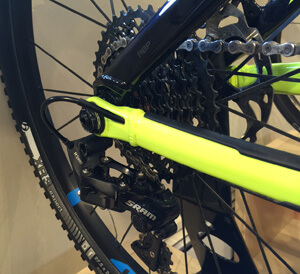
For how I use the bike, a single chainring design sounded really attractive and the SRAM X1 “1x” drivetrain that came on the Trek Fuel EX 9 27.5” has been great. I’ve been loving the fact that I don’t have to shift a front derailleur as speeds surge from 2mph to 22mph. It’s one less thing to think about as you’re continuously watching the trail in front of you for what’s coming next as you buzz up and down steep narrow hills in the woods. It also eliminates weight.
Seatpost:
I’ve been riding a standard rigid seatpost, but I will be starting to use a dropper seatpost on this bike soon. With a dropper seatpost, you can flick of a switch (or push a button…) and you can raise or lower the saddle. This allows the bike to float under you more on rough terrain or give you more clearance to move your weight back on a steep descent while still giving you full saddle height (and leg extension) for maximum climbing power. While a dropper post may not be for everyone, I think most riders will enjoy the benefits and it really is pretty easy to use. I have a Rock Shox Reverb Dropper Post.
Brakes:
While hydraulic brakes have been pretty standard on many mountain bikes for years now, the first bike I rode with hydraulic disc brakes was actually my Moots Routt gravel/adventure bike. The stopping power on my Moots Routt made it clear that hydraulic discs are the way to go for most people off-road. Hydraulic disc brakes can stop the bike on a dime when that sketchy steep section shows up. Shimano’s XT disc brakes came on my Trek Fuel EX 9 27.5” and they offer great performance and value. I can see why many people who come from a mountain bike background are interested in disc brakes on their road bike. Hydraulic disc brakes are simply stronger and they are easy to miss once you get used to the progressive and consistent stopping power they offer.
How Does My Trek Fuel EX 9 27.5” MTB Ride?
While the younger, and/or more experienced, off-road rider may look forward to hopping over most challenges on their mountain bike, let’s just say that I have no plans of entering the Red Bull Rampage anytime soon… This means that the Trek Fuel EX 9 with 120mm of travel is well suited for the type of riding I do without being overkill. Mike and I dialed in the initial suspension settings, just like we would for anyone buying a mountain bike through Fit Werx. Once dialed in and set to my riding position, the Trek Fuel EX 9 27.5” has proven more than capable of absorbing the hits that my riding throws at it. For many roadies looking to get (back) into mountain biking to compliment their road riding, bikes like the Trek Fuel EX 9 make a lot of sense. At right around $4000, it is also a lot of bike for the money.
Other MTB Options:
There is no one type of mountain bike rider or one type of mountain bike. Luckily, for those buying a mountain bike, there are a ton of great mountain bike designs available for all types of riders. For the rider looking for a little bit more big hit absorption, without giving much on the climbs, bikes like Felt’s new Decree 27.5” or an Ellsworth Epiphany (both with 150/140mm of travel) could be a great option. For a racer or traditionalist, a lighter hard-tail like a Trek SuperFly or the Moots Rogue YBB, like Ian in our VT location rides, could be the ticket. For the rider looking for the best rolling wheels for faster terrain, a 29er, like the Felt Edict that Joe in our NJ location rides, often make the most sense. And for the dedicated DH rider… Well, that is another article altogether.
What are You Waiting For?
That first perfectly awesome March road riding day is likely a ways away. However, in the meantime, don’t feel like your only option is the trainer. Take advantage of all that incredible off-road riding that surrounds us. Heck, a new mountain bike and one of the latest generation of incredible headlights may make you even forget about calling fall the “off-season”.
Contact Us to discuss a new mountain, CX, Adventure or Fat bike and make the most of this fall and next spring!

